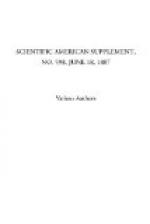We now learn that the Essen works have just begun the manufacture of a 314,600 pound gun. This piece, called “40 cm. kanone L/40,” will, of course, be of 15.6 inch caliber, but it will differ from the one above described in that its length will be equal to 40 times the caliber, say 52 feet, or to the space occupied on the maneuvering ground by a field piece drawn by six horses (Fig. 1). This gun will be provided with two kinds of projectiles. One of these, called light, will be 31/2 feet in length, weigh 1,628 pounds, and be capable of taking an initial velocity of 2,410 feet and of piercing, on its exit from the chamber, either a hammered iron plate 33/4 feet in thickness or two united plates 13/4 and 23/4 feet in thickness.
The shell called heavy will be 53/4 feet in length, and weigh 2,310 pounds, say more than a 43/4 inch siege piece! The charge employed will be 1,067 pounds of brown, prismatic Dunwald powder. Ten hundred and sixty-seven pounds—nearly half a metric ton, more than the weight of a field piece without its carriage! With this enormous charge, the heavy shell will be capable of an initial velocity of 2,100 feet and of piercing, on its exit from the chamber, either a hammered iron plate 4 feet in thickness or two united plates 2 and 2.88 feet in thickness.
The Cologne Gazette, from which we borrow most of the data just presented, adds that the “40 L/40” piece will be the largest cannon in the world, but that it will not long enjoy the privilege of such pre-eminence. It appears, in fact, that Mr. Krupp is preparing to manufacture a gun of 171/2 inch caliber, weighing 330,000 pounds. The projectile for this monster will be 6 feet in length, say the stature of a full grown man, and will weigh no less than a ton and a half. A man of medium stature will measure a little less than this projectile (Fig. 2).
It is possible that all these figures have been slightly exaggerated by the ultra-Vosges journals, who doubtless intend to make an impression upon us; but we shall not dwell upon that point.
As regards the penetrating power of the large “40 L/40” gun, the German press observes that in 1868 artillery was incapable of piercing in one-hundredths of an inch what it is now piercing in tenths of an inch. The principle was formerly admitted, it says, that a shell should by right have a thickness equal to its caliber. Now, “the largest cannon in the world” perforates a plate whose thickness is three times the diameter of the gun’s bore. What great progress! exclaim the German journals, and how jealous the French and English are going to be! Jealous of that? Why, indeed? We are not the least in the world so. How could we be? In the first place, we have a gun of very great caliber—a 131/4 inch steel coast and siege piece. This weighs 37 tons, and is 363/4 feet in length. Its projectile weighs from 924 to 1,320 pounds, according to its internal organization.




